Bond LSC News

Dec. 10, 2023
Bond LSC researchers recognized among most cited scientists of 2023
Bond LSC principal investigators Bing Yang (left) and Ron Mittler were once again recognized on the list of Highly Cited Researchers. | photos by Roger Meissen, Bond LSC By Roger Meissen | Bond LSC Discoveries in research come with time, so the incremental accumulation of knowledge toward breakthroughs is fundamental to science and the future. While many contribute to this understanding, a few scientists consistently produce research that others note more often in their own experiments. Two University of Missouri Bond Life Sciences Center researchers once again landed on that list of most…
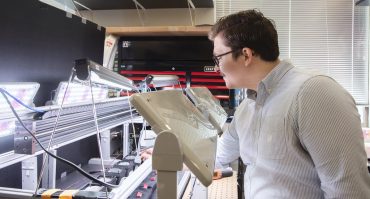
Dec. 8, 2023
OPEN leaf system offers affordable, automated option for plant data collection
Landon Swartz, a graduate research student at the University of Missouri in the David Mendoza-Cózatl lab at Bond LSC, looks at the camera on the OPEN leaf machine and makes adjustments to the plant the robot is photographing. | Photo by Sarah Kiefer, Bond LSC By Sarah Kiefer The LED lights danced as the OPEN leaf system powered up. Quickly, the robot zips down the track to its preplanned destination, hovering above each plant sitting atop a 3D-printed mechanism, then the camera snaps a shot as it conducts this same routine every 30 minutes. …
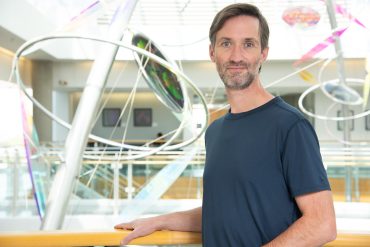
Nov. 13, 2023
Libault returns to Bond LSC as plant scientist with single cell focus
Marc Libault, a new Bond LSC principal investigator and professor of professor of plant science and technology in the College of Agriculture, Food and Natural Resources at the University of Missouri. | Photo by Sarah Kiefer, Bond LSC By Sarah Kiefer | Bond LSC Marc Libault only ended up one floor up from his old stomping ground in his recent move. Libault — the most recent MizzouForward hire at Bond Life Sciences Center — returned this fall to bring his expertise in plant single cell biology to MU. “What is exciting about this research is its innovation…
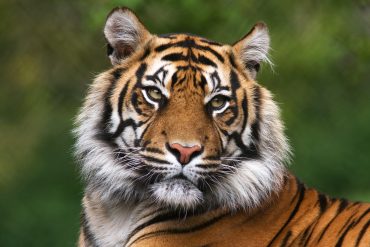
Nov. 7, 2023
How the tiger’s nose knows
The Bengal tiger was one of five feline lineages compared to gives a comprehensive look at genome sequence structures that could have driven the evolution of distinct cat species. This new reference genome is comparable to the human genome in terms of its completeness, and could be used to for feline veterinary precision health. Denise Allison Coyle/Shutterstock First-ever analysis compares nearly gapless genome across cat species and with humans to shine light on evolution By Roger Meissen | Bond LSC The tiger doesn’t know it, but a difference deep in its genome sets it apart from other cats. This…
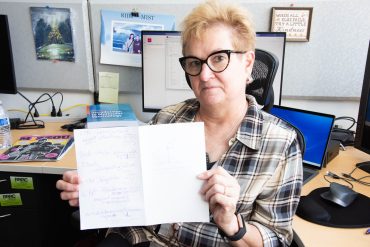
Oct. 20, 2023
Protein Fusion as the Solution—Picking’s Path to Vaccine Development
Wendy Picking, professor of veterinary pathobiology and principal investigator at Bond Life Sciences Center sits in her office and shows off some notes she jotted down about the vaccines she’s working on. | Photo by Beni Adelstein, Bond LSC By Beni Adelstein Wendy Picking uses the power of proteins to fight pesky pathogens like Pseudomonas aeruginosa. Picking and her team are one step closer to completing their mission to develop weapons like vaccines to fight against this bacterium. In March, they published these findings in Nature’s Journal, npj Vaccines. “If your immune system is weakened…
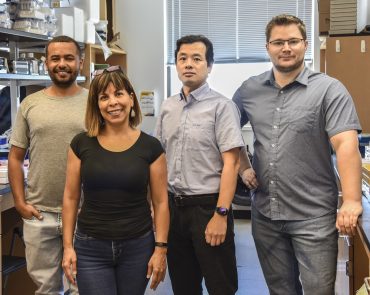
Oct. 20, 2023
Baker lab IDs rare tuft cells in salivary glands that may prove significant in Sjögren’s disease
Lab of Olga Baker, a Bond LSC researcher and professor of otolaryngology at the University of Missouri. From left to right, Harim Tavares dos Santos, Olga Baker, Kihoon Nam, and Frank Maslow. | Photo by Sarah Kiefer, Bond LSC By Sarah Kiefer A digital declutter is a way to get rid of the seemingly endless files of old photos and documents, but when Harim Tavares dos Santos started sorting through computer files from the Baker Lab at Bond LSC, one image stood out and led him down a rabbit hole. The picture showed tuft cells, a rare…
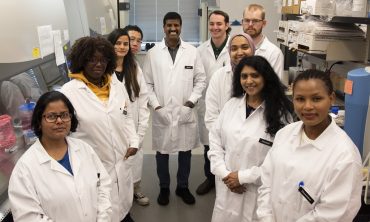
Oct. 6, 2023
Ongoing vaccine projects address 100-year-old disease and others in fight against tick-borne diseases
Lab of Roman Ganta, Bond LSC principal investigator and McKee endowed professor of veterinary pathobiology. | Photo by Sarah Kiefer, Bond LSC By Sarah Kiefer It only takes a quiet walk through the Missouri woods to encounter ticks. As they crawl from the rich vegetation among the bushes and grass onto humans and animals alike, they wreak havoc on their hosts by passing on disease causing bacterial pathogens. One of those pathogens known to cause a 100-year-old disease is Rocky Mountain Spotted Fever (RMSF). University of Missouri scientist, Roman Ganta, hopes to understand its inner workings to…
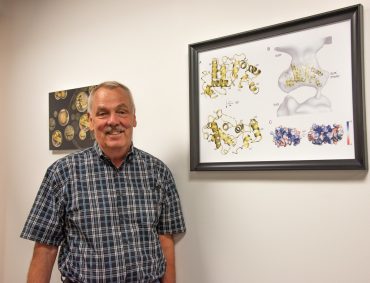
Sep. 28, 2023
Zooming in on the tools: T33 Secretion System
Zooming in on the tools: TS33 Secretion System William Picking standing next to a poster from his work in the Journal of Molecular Biology. This diagram depicts the structure of protein PscK from the pathogen Pseudomonas Lanuginose, which is used in a system to inject toxins into immune cells. Images A and C depict the protein’s structure and image B shows how the protein is used with a secretion apparatus. Salmonella is one bacterium everyone’s heard of. It’s the scourge of meatpacking plants and involved in spinach recalls every year, causing unwelcome intestinal unrest and dangerous disease…
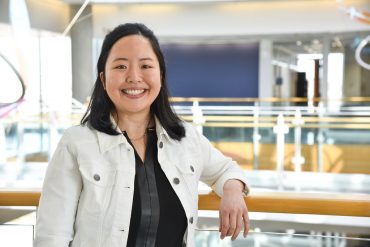
Sep. 19, 2023
Fellowship Spotlight: Cynthia Tang
Research skills aren’t built in a day, but Cynthia Tang’s diligence brought those skills to bear as she recently received an NIH fellowship to further her budding career in science. “Receiving the F30 fellowship means that the NIH sees value in my research proposal, in my training environment at the University of Missouri, and in my potential to become an independent physician-scientist,” said Tang, who works in Henry Wan’s lab at Bond LSC. The F30 predoctoral fellowship supports the research of students pursuing M.D-Ph.Ds. These awards can help Tang and others pursue their passions…
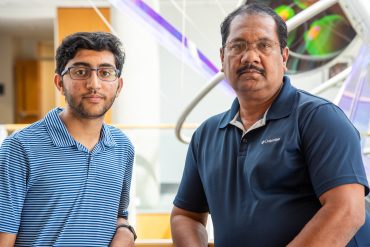
Sep. 13, 2023
Singh lab finds new protein that induces the effects of the COVID-19 vaccine and the treatment drug remdesivir
Kamal Singh (right), a principal investigator at Bond Life Sciences Center, assistant professor in the MU College of Veterinary Medicine, and the director of the Molecular Interactions Core stands next to Saathvik Kannan (left), a senior at Hickman High School and a computer programmer and researcher for the Singh lab. | Photo by Roger Meissen, Bond LSC By Sarah Kiefer The spikes that protrude from SARS-CoV-2 present a topography of peaks that drive one MU researcher to ask more questions. To Kamal Singh, a principal investigator at Bond Life Sciences Center, assistant professor in the MU College…
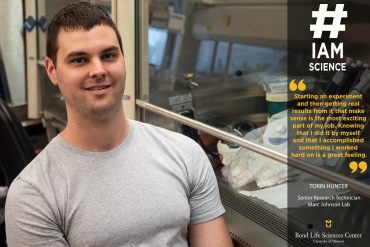
Sep. 1, 2023
#IAmScience Torin Hunter
By Sarah Kiefer The hunt for emerging coronavirus variants keeps Torin Hunter busy testing samples from sewer systems across Missouri. As a part of The Sewershed Surveillance Project, Hunter has spent the last year and a half taking each test tube and carefully filtering the samples to contribute data on how SARS-CoV-2 can be present in our communities. But Hunter started his journey in virology like many — a student trying to sift through all the different subjects and figuring out what fit him the best. He tried out clinical jobs and considered going into…
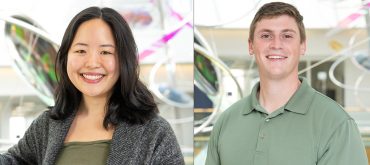
Aug. 28, 2023
Second time’s the charm: Tang and Thomas awarded NIH F30 fellowships, a first at MU
By Beni Adelstein | Bond Life Sciences Center M.D-PHD candidates Cynthia Tang and Brian Thomas share their experience applying for the NIH F30 Fellowship. | Photos by Roger Meissen Brian Thomas got the official letter in the mail Monday after months of waiting. “It’s a long time coming,” he said, “lots of patience and collaboration.” Thomas is one of two student scientists at Bond Life Sciences Center to receive F30 fellowships — officially the Ruth L. Kirschstein National Research Service Award (NRSA) — from the National Institutes of Health (NIH) this year, a first…